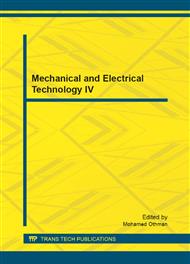p.1823
p.1827
p.1831
p.1835
p.1840
p.1846
p.1850
p.1854
p.1858
Design and Simulation of a Type of Four Degrees of Freedom Parallel Robot
Abstract:
A type of four degrees of freedom parallel robot is designed, which can make the workbench achieve the translational motion of three directions and one rotational motion. The constituent part of the robot is given. And we analyze the design principle and process of its work space. Though the CATIA simulation software, the whole movement of the robot is dynamically presented, showing the features of the various body parts and verifying the feasibility of its practical movement.
Info:
Periodical:
Pages:
1840-1845
Citation:
Online since:
November 2012
Authors:
Keywords:
Price:
Сopyright:
© 2012 Trans Tech Publications Ltd. All Rights Reserved
Share:
Citation:


